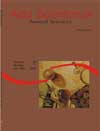<b>Evaluation of Nile tilapia strains (<em>Oreochromis niloticus</em>) in different phases of rearing</b> - DOI: 10.4025/actascianimsci.v26i2.1864
Abstract
The present research had as objectives to evaluate the productive performance during the initial phase and growing and the fillet yield obtained in the fatten phase of different strains of Nile tilapia existents in Brazil. The studied strains were: the intraspecific hybrid (HIB), resulting from crossing between the male Chitralada (Thailand), and the female Bouaké (Brazilian); the Bouaké (BOK) popularly known like Nile tilapia; the Chitralada, first Thailand generation (CHI1); the Chitralada, second Thailand generation (CHI2). This experiment was carried out in the period from December 2000 to August 2001 and had four phases as characteristic. To the three first phases was used an installation type greenhouse, with 24 boxes, with capacity to 250L, where were tested the four treatments, with six replicates. To the fourth phase, the fishes were individually marked and put in a land tank with 300m². The obtained results to the final weight for the growing phase (3a phase) were: 93,66g (HIB); 71,79g (BOK); 108,17g (CHI1) e 114,31g (CHI2), and for apparent feed conversion ratio 1,77 (HIB); 1,98 (BOK); 1,46 (CHI1) e 1,45 (CHI2) and for weight gain there was the increasing from 47% to 49% (CHI1 and CHI2, respectively) and 17% (HIB) in relation to BOK. The CHI1 and CHI2 and the HIB showed a mayor tolerance and a mayor storage density and final biomass than the BOK. To the average values of carcass weight in the fatten phase (4ª phase) were: 261,99g (HIB); 177,98g (BOK); 292,75g (CHI1) e 307,82g (CHI2); the strains CHI1, CHI2 and the HIB presented the best results, obtaining significative differences of BOK. The results obtained to fillet yield showed that there was no significative difference between the strains. These results showed, that the strains with best general performance, was Chitralada (CHI1 and CHI2), followed by hybrid (HIB) and the Bouaké (BOK) strains.Downloads
Download data is not yet available.
Published
2008-04-09
How to Cite
Wagner, P. M., Ribeiro, R. P., Moreira, H. L. M., Vargas, L., & Povh, J. A. (2008). <b>Evaluation of Nile tilapia strains (<em>Oreochromis niloticus</em>) in different phases of rearing</b> - DOI: 10.4025/actascianimsci.v26i2.1864. Acta Scientiarum. Animal Sciences, 26(2), 187-196. https://doi.org/10.4025/actascianimsci.v26i2.1864
Issue
Section
Animal Science
DECLARATION OF ORIGINALITY AND COPYRIGHTS
- I Declare that current article is original and has not been submitted for publication, in part or in whole, to any other national or international journal.
The copyrights belong exclusively to the authors. Published content is licensed under Creative Commons Attribution 4.0 (CC BY 4.0) guidelines, which allows sharing (copy and distribution of the material in any medium or format) and adaptation (remix, transform, and build upon the material) for any purpose, even commercially, under the terms of attribution.
Read this link for further information on how to use CC BY 4.0 properly.
0.9
2019CiteScore
29th percentile
Powered by 








































